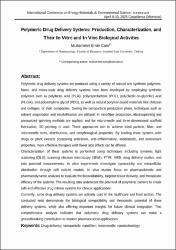Polymeric drug delivery systems: Production, characterization, and their in vitro and in vivo biological activities
Citation
Çam, Muhammet Emin. Polymeric drug delivery systems: Production, characterization, and their in vitro and in vivo biological activities. International Conference on Energy Materials & Environmental Science: ICEMES'2025. April 8-10, 2025 Casablanca (Morocco).Abstract
Polymeric drug delivery systems are produced using a variety of natural and synthetic polymers.
Nano- and micro-scale drug delivery systems have been developed by employing synthetic
polymers such as polylactic acid (PLA), polycaprolactone (PCL), poly(lactic-co-glycolic) acid
(PLGA), and polyethylene glycol (PEG), as well as natural polymer-based materials like chitosan
and collagen, or their composites. During the nanoparticle production phase, techniques such as
solvent evaporation and emulsification are utilized; in nanofiber production, electrospinning and
pressurized spinning methods are applied; and for microneedle and three-dimensional scaffold
fabrication, 3D printing is used. These approaches aim to achieve ideal particle, fiber, and
microneedle sizes, distributions, and morphological properties. By loading these systems with
drugs or plant extracts possessing anticancer, anti-inflammatory, antidiabetic, and antioxidant
properties, more effective therapies with fewer side effects can be offered.
Characterization of these systems is performed using techniques including dynamic light
scattering (DLS), scanning electron microscopy (SEM), FTIR, XRD, drug delivery studies, and
zeta potential measurements. In vitro experiments investigate cytotoxicity and intracellular
distribution through cell culture models. In vivo studies focus on pharmacokinetic and
pharmacodynamic analyses to evaluate the bioavailability, targeted tissue delivery, and therapeutic
efficacy of the systems. The resulting data underscore the potential of polymeric carriers to create
safe and effective drug release systems for clinical applications.
Currently, some drug delivery systems are actively used in the healthcare and food sectors. The
conducted tests demonstrate the biological compatibility and therapeutic potential of these
delivery systems, while also offering important insights for future clinical integration. This
comprehensive analysis indicates that polymeric drug delivery systems can make a
groundbreaking contribution to modern pharmaceutical applications.


















